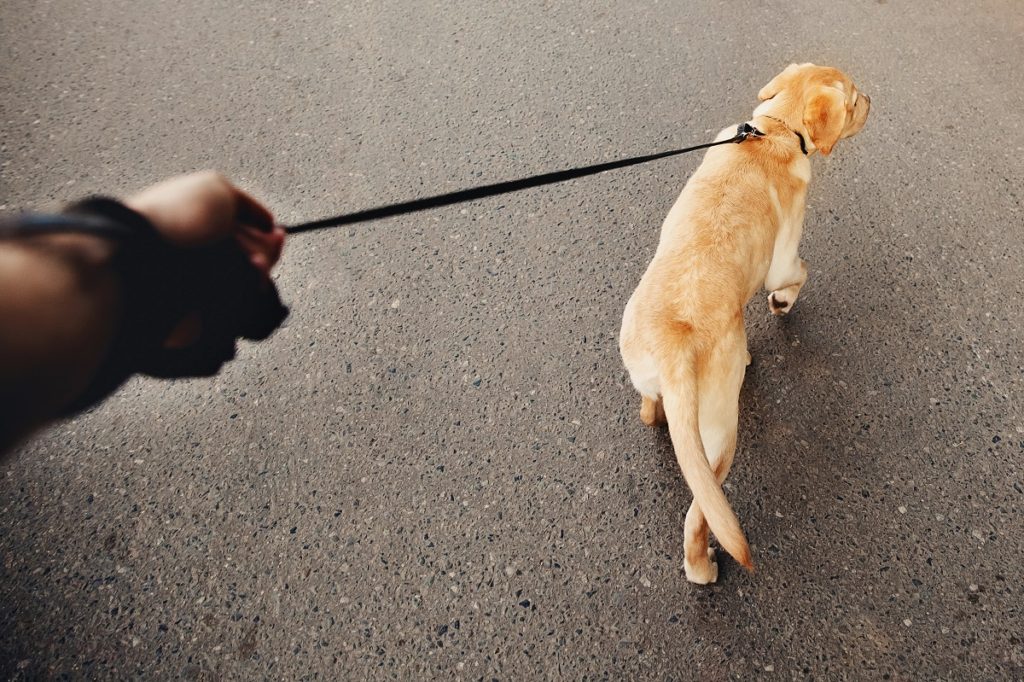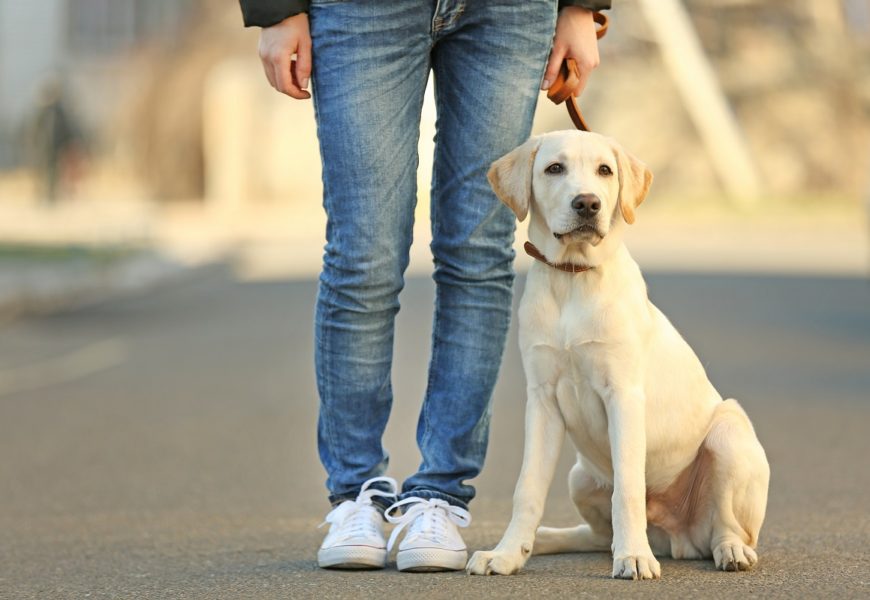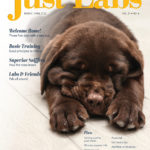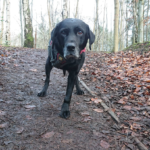Lesson 1: Loose-lead walking and the sit command.
Once you have decided to pursue a Canine Good Citizen title for your Lab, how do you get started? It’s important to recognize that there are two major components to preparing for the CGC test: training on some basic commands; and conditioning your Lab to environmental challenges he will face on the test.
If you have access to a good community training class, I recommend enrolling with your Lab. A class has many advantages, including motivation, camaraderie, and classmates who can be allies to help with the skills involving people and other dogs. There’s more than one way to train a dog, so if your class teaches a different approach than what I describe, fine! Reading this series may still help you understand how your Lab learns and give you ideas for using distractions effectively.
If you are planning ahead and have a young puppy, or will soon be getting a puppy, you can get a good head start by taking advantage of your puppy’s “primary socialization period” of up to about 16-18 weeks of age. During this window, your puppy is likely to respond to novel experiences with curiosity and a minimum of fear. We expect that the environmental stimuli he encounters during this time will be easier for him to negotiate later, and that a variety of experiences in this stage will help him become a more confident adult.
In thinking up possible exposures for your puppy, consider a variety of sights, sounds, and scents (including bright lights and loud noises); a variety of surfaces on which to walk; and a variety of people of different ages, races, and styles of clothing, including hats, helmets, and facial hair. The people do not all need to pet your puppy, but he needs an opportunity to observe them and become accustomed to being around them. Good places to go are inside stores that allow dogs (he can ride in a shopping cart to minimize his contact with the floor and other dogs), places he can see and hear traffic, and near community sporting events where the crowd may be loud and excited.
It is important to recognize that the name usually applied to this process – “socialization” – is misleading. The goal is exposure to a variety of environments and stimuli, not extensive interactions with people and other dogs. Be aware that if you condition your puppy to expect to play vigorously with every human or dog he sees, you will have extra work to prepare for the tests that involve responding calmly to people and dogs.
If your Lab is already an adult, we will begin training first and then practice around a variety of stimuli and in different environments so he will learn to respond to different situations with aplomb. You may not have taken full advantage of your Lab’s primary socialization period. This happens a lot, especially as many veterinarians advise us not to take a puppy anywhere before his vaccination series is complete. Don’t worry. Most Labs are resilient and adaptable, and will develop confidence through training.
Training may seem to begin slowly, but try not to be impatient to get to fully executed commands. Your Lab will have a lot to process in these early exercises, and mastering them first will lead to smooth progress with a minimum of conflict and correction.
We will begin with loose lead walking. The equipment needed for this lesson will be a 15-foot longe line, and a chain collar or pinch collar. If your Lab routinely pulls during walks, you probably have habits that need to change, too. Dogs respond by pulling when they are pulled on, so you need to completely eliminate the habit of pulling on your Lab. Need to move him from here to there? Use gestures and voice to let him know what you want. Need to keep him close at your side? This will become easier as training progresses, but for now, recognize that being restrained on a taut lead is not the same as being close to you on a short lead. As you and your Lab learn to keep slack in the lead, the latter will become easier to accomplish.

If you use a retractable lead, put it away (or give it away, or throw it away). Because it teaches the dog he must pull in order to go anywhere, it is a huge obstacle in trying to teach him not to pull. Instead, we start off with a 15-foot line, such as a cotton longe line used with horses and sold at tack shops (and online). You and your Lab may need to adjust to the fact that he will sometimes step over the line, even get it looped around his legs or body. That’s okay!
I like to attach the line to a chain collar (a.k.a. “choke collar”). The shortest collar that will easily go over your Lab’s head is the right length. If you feel you are not strong enough to carry out the following instructions with your Lab, you might prefer to try a pinch collar made up of links that rotate and press into your dog’s neck. Labs normally will not pull as hard against this kind of collar, as long as it is properly adjusted. (Adjust a pinch collar by removing links until the collar sits fairly high on your Lab’s neck rather than falling slack. If too much slack is allowed, the links will not rotate and the effect will be lost.)
Begin in a place where there are relatively few distractions and no hazards that would cause you to feel the need to “rein in” your Lab. You will allow him the full 15 feet of line in which to move around – that’s a 30-foot diameter circle. If your yard is big enough, great. Other places you could train are parking lots of businesses that are closed, public parks when the hour or weather keeps most people away, etc. Be sure to clean up after your dog as needed.
Training begins as a walk, but a walk with rules. The main rule is that if your Lab pulls, you will stop and stand, unyielding. You will not budge until he gives up pulling and moves in your direction enough to create some slack in the line. When he does, say, “Good!” in a calm voice and resume walking forward. You will not rein your dog in or pull on him, except that if you feel him digging in or pulling in the backward direction, you will dig in and keep moving forward. Don’t look at him; just keep going. You don’t want to create the impression you are negotiating. Instead, you establish that you get to go where you will. He has a 30-foot-diameter circle in which he can do anything he wants without getting dragged or making you stop. He can figure it out.
Speaking of, let’s talk about what “figuring it out” looks like. Training works through repetition, and learning involves getting it right, getting it wrong, experiencing the difference in outcomes, and repeating both success and failure while discovering that the consequences remain the same over time.
If your Lab is in the habit of pulling when you begin this training, he has learned to think that it works – that pulling will be rewarded by progress toward the thing he wants to investigate. Even after a few successes in keeping the lead slack, it is normal for your Lab to try out his former learned behavior of pulling toward destinations that interest him. Do not be discouraged by a mixture of successes and lapses. This is the learning process! Focus on your consistency of handling as he works it out.
You must be consistent in keeping a slack lead and never moving forward when your Lab pulls. Learning theory explains that if your Lab occasionally has success by pulling, the pulling behavior will become even more persistent. Unpredictable rewards reinforce behavior, which is why dog trainers emphasize the need for consistency. When teaching a dog not to pull, this means you must not absentmindedly restrain him at any time. Since you are working to change your own habit, it is a good idea to pause prior to any situation (such as a vet trip or guests at the door) and visualize how you will manage your Lab.
As your Lab learns the advantage of keeping the line slack, make use of distractions to further develop the skill. Perhaps your training area contains points of interest that attract your Lab, giving you plenty of opportunity to practice stopping and waiting. The closer you get to one of these temptations, the stronger the attraction and therefore the greater the challenge for your Lab. Adjust how closely you pass so that your Lab is able to resist temptation about three times out of four.
Once your Lab masters his impulsiveness around the familiar distractions in your training site, add some new ones. In his CGC test, he will need to remain calm and responsive around a variety of environmental and engineered distractions. The test description lists … Some other things you can place around your training site include…
Continue to adjust distance from each distraction to maintain a success ratio of approximately three out of four.
An easy way to introduce commands like sit and down is in the form of activities you do on your walk. We will defer the down and begin work on sit.
You must be consistent in keeping a slack lead and never moving forward when your Lab pulls. Learning theory explains that if your Lab occasionally has success by pulling, the pulling behavior will become even more persistent.
Begin at a time when your Lab is past any early session excitement and is moving calmly. Take up slack in the line and work your way to him. Take a position so that he is standing on your left (remembering not to try to move him around using the line). With your right hand, take hold of your line at the snap that connects to his collar. Place your left hand on his rear (not his back). Pull up and slightly back on his neck as you push down on his rear. He may resist at first but should eventually relax into a sitting position. Say, “Sit!” As his rear gets close to the ground, then immediately release all pressure while telling him, “Good boy; okay!” (Okay is a release command. This lets your Lab know when his responsibility is over. You might prefer to use a word or short phrase you are less likely to say in conversation, such as “kumquat.”)
The immediate release of pressure along with your praise is your Lab’s reward for complying, so don’t make the mistake of forcing him to stay in position. All you are asking for at this point is for him to give in to the pressure you are applying. Treat the introduction of the sit exercise as a new game rather than focusing on the need to get the command right. You will get quicker compliance and cut down on the need to push and pull as your Lab learns that giving in gets him praise and the opportunity to continue what he was doing.
Sprinkle repetitions of sit throughout your walk, always praising and letting your Lab go back to what he was doing. When he begins to melt into a sit before any pressure is applied, begin giving the command at the beginning of the exercise as you take hold of the line at the snap. Praise him as his rear end reaches the ground, as before, but now delay for half a second before you release him and tell him, “Okay!”
Once your Lab will delay getting up for half a second, it is pretty easy to increase the lag time to a full second, then two seconds, and so on. When he will pause for five seconds waiting for your okay release, he has the foundation he needs for the next two skills – the sit-stay, and recall.
Begin practicing sit closer to distractions. Our goal is for your Lab to respond correctly no matter what is going on around him. The pattern we will follow for each exercise is to begin in a low-distraction setting, conditioning your Lab to respond around distractions after he masters the basic skill.
Training should be a pleasant experience for you and for your Lab. It is a walk together, with rules, punctuated by sit practice. In my next column we will add the sit-stay, which develops self-control, and the recall, which is fun.




